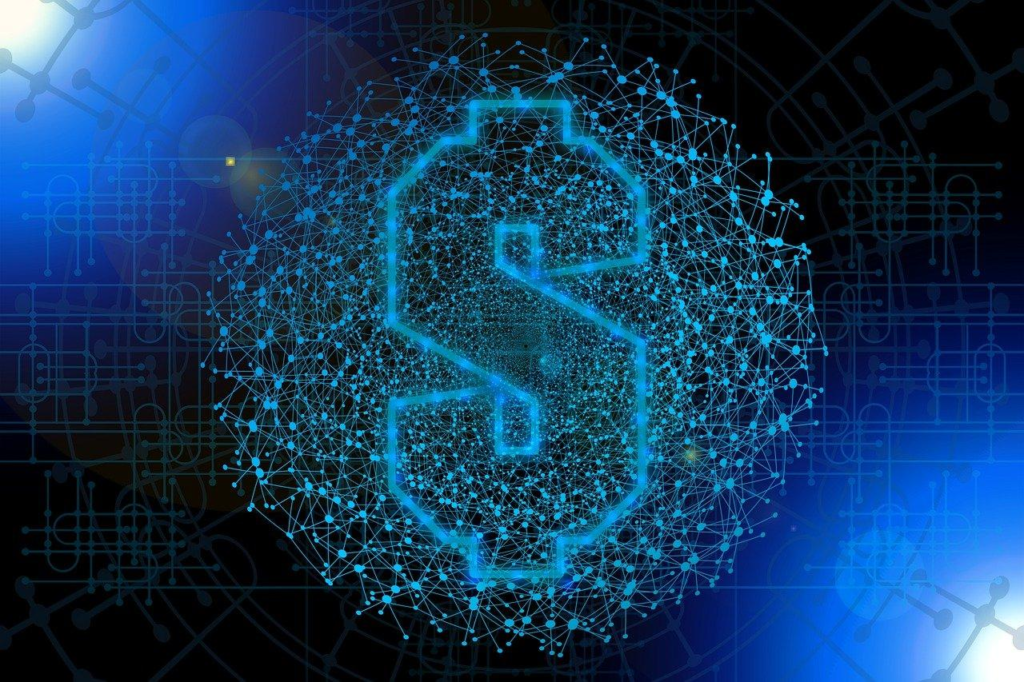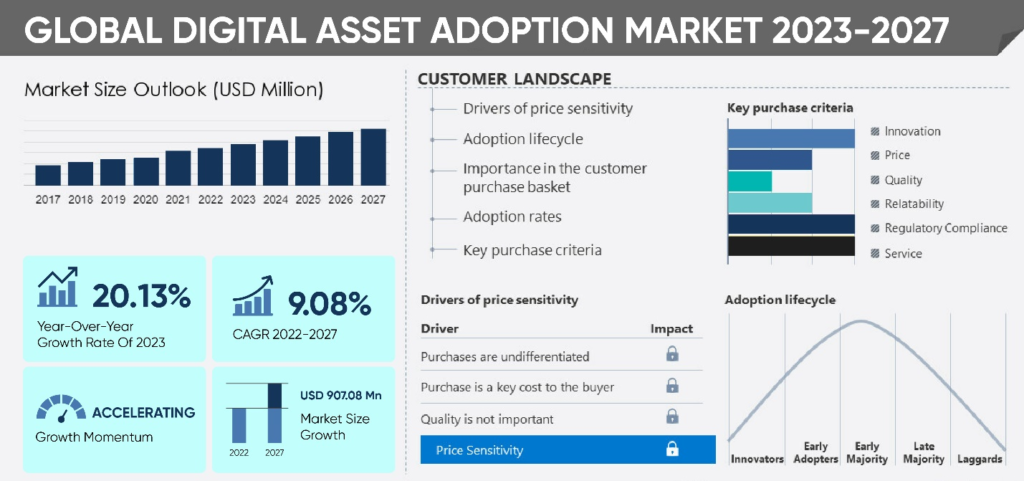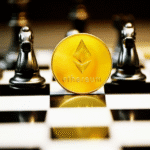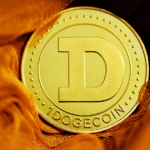
In the past decade, digital assets, encompassing everything from cryptocurrencies to NFTs, have made the world witness a transformative shift in how value is created, stored, transferred, and perceived.
What began as a niche interest within tech circles has now evolved into a widespread phenomenon, influencing financial markets, investment strategies, and regulatory frameworks worldwide.
This global adoption of digital assets is more than just a financial trend—it’s a movement reshaping the fabric of economic systems, regulatory landscapes, and individual financial autonomy. This shift is underpinned by blockchain technology—a decentralized ledger system that ensures transparency and security.
| What Are Digital Assets? Digital assets are cryptographic representations of value, often stored and transferred electronically using blockchain technology. This decentralized ledger system ensures transparency, security, and immutability of transactions. While Bitcoin remains the most well-known, the digital asset universe has expanded to encompass a multitude of tokens with varying functionalities, including utility tokens, security tokens, and stablecoins. |
Popular Types of Digital Assets
Bitcoin (BTC)
Bitcoin, created in 2009 by an anonymous entity known as Satoshi Nakamoto, was the first cryptocurrency and remains the most well-known and valuable. Bitcoin’s main features include:
- Decentralization: Bitcoin operates on a decentralized network, meaning no single entity or government controls it. Transactions are verified by network nodes through cryptography and recorded on a public ledger called the blockchain.
- Limited Supply: Bitcoin has a capped supply of 21 million coins, which introduces scarcity and is often compared to gold in terms of its role as a store of value.
- Proof of Work (PoW):Bitcoin utilizes a PoW consensus mechanism, where miners must solve complex mathematical puzzles to authenticate and add transactions to the blockchain. This process requires significant computational power and energy.
Ethereum (ETH)
Ethereum, launched in 2015 by Vitalik Buterin and other developers, extends the concept of blockchain beyond just a digital currency – it’s a blockchain platform designed to support smart contracts and decentralized applications (dApps).
Ethereum’s current consensus mechanism is PoW, but it is transitioning to Proof of Stake (PoS) with Ethereum 2.0 to improve scalability and reduce energy consumption.
- Smart Contracts: Ethereum’s core innovation is the implementation of smart contracts—self-executing contracts with code-based terms that automatically execute when certain conditions are met. This feature enables complex decentralized applications (dApps) and decentralized finance (DeFi) platforms.
- Ether (ETH):The native cryptocurrency of the Ethereum network, Ether, is used to pay for transaction fees and computational services on the network. It also serves as a store of value and medium of exchange.
- Ethereum 2.0:Ethereum is undergoing a major upgrade to Ethereum 2.0, which aims to transition from a PoW to a Proof of Stake (PoS) consensus mechanism, enabling scalability and reducing energy consumption.

Stablecoins
Stablecoins are designed to maintain a stable value by being pegged to traditional assets such as fiat currencies or commodities. Examples include Tether (USDT), USD Coin (USDC), and Dai (DAI).
Stablecoins aim to combine the benefits of cryptocurrencies (such as fast and low-cost transactions) with the stability of traditional fiat currencies. They are widely used in trading, lending, and as a medium of exchange within the crypto ecosystem.
Types of Stablecoins
- Fiat-collateralized Stablecoins:Backed by reserves of fiat currency (e.g., USDT, USDC), these stablecoins aim to maintain a 1:1 value ratio with their collateral.
- Crypto-collateralized Stablecoins:Backed by a reserve of other cryptocurrencies, often over-collateralized to account for volatility (e.g., DAI).
- Algorithmic Stablecoins: Use algorithms to control the supply of the stablecoin, adjusting its supply based on demand to maintain a stable value (e.g., Terra’s LUNA).
Tokens
Tokens are digital assets that represent a particular asset or utility within a blockchain ecosystem. Unlike cryptocurrencies, which are primarily used as a medium of exchange or store of value, tokens can have various functions depending on their type.
Utility Tokens
Utility tokens provide users with access to a product or service within a blockchain-based ecosystem. They are often issued during Initial Coin Offerings (ICOs) or Initial DEX Offerings (IDOs) to fund the development of a project.
Binance Coin (BNB): Initially launched as a utility token for the Binance cryptocurrency exchange, BNB can be utilized to pay for the platform’s transaction fees, participate in token sales, and access various services within the Binance ecosystem.
Chainlink (LINK): Chainlink’s LINK token is used to pay for services on the Chainlink network, which provides decentralized oracles to smart contracts. This enables smart contracts to securely interact with real-world data and external APIs.
Uniswap (UNI): UNI is the governance token for the Uniswap decentralized exchange, allowing holders to participate in decision-making processes regarding the platform’s development and upgrades.
Security Tokens
Security tokens represent ownership of traditional real-world assets, such as shares in a company, real estate, or other financial instruments. They are subject to securities regulations and offer the benefits of blockchain technology, such as transparency and fractional ownership. Key features include:
Regulatory Compliance: Security tokens must comply with securities laws and regulations, providing investor protections and legal rights similar to traditional securities.
Fractional Ownership: Security tokens can represent fractional ownership of high-value assets, making it easier for investors to participate in markets that were previously inaccessible.
Liquidity: By leveraging blockchain technology, security tokens can provide increased liquidity for traditionally illiquid assets, allowing for easier trading and transfer.
Asset-backed Tokens
Asset-backed tokens are pegged to physical or digital assets, providing a representation of ownership or a claim on those assets.
Examples:
Gold-backed Tokens: Represent ownership of physical gold, such as PAX Gold (PAXG), where each token is backed by a specific amount of gold held in reserve.
Real Estate-backed Tokens: Provide fractional ownership in real estate assets, offering investors exposure to real estate markets without requiring full property ownership.
Asset-backed tokens offer a way to digitize and trade physical assets, making it easier for investors to gain exposure to asset classes like gold or real estate.
Non-Fungible Tokens (NFTs)
NFTs are unique digital assets that represent ownership or authenticity of a specific item or piece of content. Unlike cryptocurrencies, which are interchangeable and have identical value, each NFT is distinct and cannot be replaced or exchanged on a one-to-one basis.
Characteristics of NFTs
Uniqueness: Each NFT has unique attributes or metadata that distinguish it from other tokens. This uniqueness is often represented by a specific identifier or digital signature recorded on the blockchain.
Indivisibility: NFTs can’t be divided into smaller units. Unlike cryptocurrencies, which can be split into fractions, NFTs are owned, sold, and bought, as whole items.
Ownership and Provenance: The blockchain provides a transparent and immutable record of ownership and provenance, ensuring that the authenticity and history of the NFT can be verified.
Examples of NFTs Usage
Digital Art: Artists and creators can mint NFTs to represent digital art pieces, enabling them to sell their work directly to collectors and retain a share of future sales through royalties. Examples include Beeple’s digital art sold for millions at auction.
Collectibles: NFTs are used to create and trade digital collectibles, such as virtual trading cards or in-game items. Platforms like NBA Top Shot allow users to buy, sell, and trade collectible moments from basketball games.
Virtual Real Estate: Virtual worlds and metaverses, such as The Sandbox or Decentraland, use NFTs to represent virtual properties and land ownership. Users can purchase, develop, and trade virtual real estate within these platforms.
Music and Media: Musicians and content creators can use NFTs to monetize their work by offering exclusive content, concert tickets, or digital memorabilia to their fans. For example, Kings of Leon released an album as an NFT, providing additional perks to buyers.

Factors Driving Global Adoption of Digital Assets
The global adoption of digital assets is driven by a confluence of factors that collectively reshape financial systems, regulatory environments, and societal attitudes towards value and technology. Here are some key factors fueling this widespread acceptance:
Technological Advancements
Blockchain Technology
Blockchain technology, the backbone of most digital assets, provides a decentralized and immutable ledger that enhances transparency and security. The ability to record transactions in a way that is resistant to tampering and fraud makes blockchain a foundational technology for digital assets. The advancement of blockchain platforms, including Ethereum and newer iterations, has enabled the development of more sophisticated digital assets and applications.
Smart Contracts
Smart contracts automate and enforce contractual agreements through code, reducing the need for intermediaries and lowering transaction costs. This functionality has expanded the potential use cases for digital assets, from decentralized finance (DeFi) to supply chain management, by providing a trustless environment where transactions are executed automatically when conditions are met.
Improved Scalability and Efficiency
Ongoing developments in blockchain technology aim to address scalability issues that have historically plagued digital assets. Innovations such as layer-2 solutions, sharding, and the transition to Proof of Stake (PoS) consensus mechanisms have improved transaction speeds and reduced costs, making digital assets more practical for everyday use and large-scale adoption.

Financial Inclusion and Accessibility
Access to Banking Services
Digital assets provide an alternative to traditional banking services, particularly for individuals in underserved or unbanked regions. Cryptocurrencies and blockchain-based platforms enable financial transactions without the need for traditional banking infrastructure, offering a means to participate in the global economy for those who lack access to conventional financial services.
Lower Transaction Costs
Digital assets can significantly reduce transaction fees compared to traditional financial systems. For example, cross-border transactions using cryptocurrencies can bypass intermediaries and reduce costs associated with currency conversion and bank fees. This cost-effectiveness is particularly beneficial for remittances and international trade.
Inclusion of Diverse Investment Opportunities
Digital assets offer new investment opportunities beyond traditional stocks and bonds. With the rise of cryptocurrencies, tokenized assets, and NFTs, investors have access to a broader range of assets and markets. This diversification allows individuals to participate in new financial ecosystems and potentially benefit from emerging trends.
Institutional Adoption and Investment
Increasing Institutional Participation
The involvement of institutional investors, including hedge funds, venture capital firms, and publicly traded companies, has lent credibility to digital assets. Institutions are investing in cryptocurrencies and blockchain technology, contributing to increased market stability and legitimizing digital assets as an asset class.
Development of Financial Products
The creation of financial products and services related to digital assets, such as Bitcoin futures, ETFs, and crypto-based investment funds, has facilitated institutional and retail investor access. These products provide traditional investors with exposure to digital assets without needing to directly hold or manage them.
Integration with Traditional Financial Systems
Financial institutions are increasingly integrating digital assets into their operations, offering services such as custody solutions, trading platforms, and payment processing. This integration bridges the gap between traditional finance and the digital asset ecosystem, making it easier for individuals and businesses to engage with digital assets.

Regulatory Developments
Evolving Regulatory Frameworks
Governments and regulatory bodies worldwide are developing and refining frameworks to address digital assets. Clearer regulations help to mitigate risks related to fraud, money laundering, and market manipulation while fostering a safer environment for investment and innovation. Regulatory clarity also encourages institutional participation and public confidence.
Legal Recognition and Compliance
The legal recognition of digital assets, including the classification of cryptocurrencies and tokens, provides legitimacy and protection for investors and businesses. Compliance with anti-money laundering (AML) and know-your-customer (KYC) regulations ensures that digital asset transactions adhere to established financial practices.
International Cooperation
International cooperation among regulators and financial authorities is crucial for addressing cross-border challenges related to digital assets. Collaborative efforts aim to create consistent regulatory standards and facilitate global trade and investment in digital assets.
Economic and Societal Trends
Digital Transformation
The broader trend towards digital transformation across industries has accelerated the adoption of digital assets. As businesses and consumers increasingly engage with digital technologies, the integration of digital assets into everyday transactions and financial systems becomes more natural and widespread.
Changing Attitudes Towards Privacy and Security
Growing concerns about privacy and security in traditional financial systems have driven interest in digital assets. Cryptocurrencies and blockchain technology offer enhanced privacy features and security measures, appealing to individuals seeking greater control over their financial data and transactions.
Market Sentiment and Media Influence
Positive media coverage and endorsements from high-profile figures and industry leaders contribute to the growing acceptance of digital assets. Public perception and market sentiment play a significant role in driving adoption, as increased visibility and validation can lead to greater interest and investment.
Impacts on the Global Economy
The widespread adoption of digital assets is having a profound impact on the global economy, influencing financial systems, market dynamics, and economic structures. These impacts can be observed across various dimensions, including financial markets, regulatory frameworks, economic inequality, and innovation. Here’s an in-depth look at the key impacts on the global economy:
Transformation of Financial Systems
Disintermediation
Digital assets, particularly cryptocurrencies and blockchain technology, facilitate direct transactions between parties without the need for intermediaries such as banks or payment processors. This disintermediation reduces transaction costs, increases efficiency, and challenges traditional financial institutions’ roles in facilitating payments and managing transactions.
Enhanced Transparency and Security
Blockchain technology provides a transparent and immutable ledger of transactions, which enhances security and reduces the risk of fraud. This increased transparency helps build trust in financial systems and improves accountability, potentially reducing corruption and improving regulatory compliance.
New Financial Products and Services
The rise of digital assets has led to the creation of innovative financial products and services, including decentralized finance (DeFi) platforms, security tokens, and digital asset management solutions. These innovations expand the range of financial services available and provide new investment opportunities, contributing to a more dynamic financial ecosystem.
Impact on Global Trade and Investment
Cross-Border Transactions
Digital assets enable faster and more cost-effective cross-border transactions. Cryptocurrencies can facilitate international payments without the need for currency conversion or intermediary banks, reducing fees and processing times associated with traditional international transactions. This efficiency can benefit global trade and investment by making transactions more seamless and accessible.
Increased Market Liquidity
The digitization of assets and the development of trading platforms have increased market liquidity. Digital assets can be traded 24/7 on various exchanges, providing investors with greater flexibility and opportunities for trading. Enhanced liquidity can lead to more efficient price discovery and reduced market volatility.
Diversification of Investment Portfolios
Digital assets offer investors new avenues for diversification. The ability to invest in cryptocurrencies, tokenized assets, and NFTs allows for the inclusion of alternative investments in portfolios. This diversification can help manage risk and potentially enhance returns, contributing to a more diversified and resilient investment landscape.
Economic Inclusion and Empowerment
Access to Banking Services
Digital assets provide an alternative to traditional banking services, particularly for individuals in underserved or unbanked regions. Cryptocurrencies and blockchain-based platforms enable financial transactions without the need for traditional banking infrastructure, offering a means to participate in the global economy for those who lack access to conventional financial services.
Lower Transaction Costs
Digital assets can significantly reduce transaction fees compared to traditional financial systems. For example, cross-border transactions using cryptocurrencies can bypass intermediaries and reduce costs associated with currency conversion and bank fees. This cost-effectiveness is particularly beneficial for remittances and international trade.
Microtransactions and New Economic Models
Digital assets also enable microtransactions, which are small-value transactions that are often impractical with traditional payment systems due to high fees. This capability supports new economic models, such as pay-per-use services and content monetization, and fosters the growth of digital economies based on micropayments.
Inclusion of Diverse Investment Opportunities
Digital assets offer new investment opportunities beyond traditional stocks and bonds. With the rise of cryptocurrencies, tokenized assets, and NFTs, investors have access to a broader range of assets and markets. This diversification allows individuals to participate in new financial ecosystems and potentially benefit from emerging trends.

Institutional Adoption and Investment
Increasing Institutional Participation
The involvement of institutional investors, including hedge funds, venture capital firms, and publicly traded companies, has lent credibility to digital assets. Institutions are investing in cryptocurrencies and blockchain technology, contributing to increased market stability and legitimizing digital assets as an asset class.
Development of Financial Products
The creation of financial products and services related to digital assets, such as Bitcoin futures, ETFs, and crypto-based investment funds, has facilitated institutional and retail investor access. These products provide traditional investors with exposure to digital assets without needing to directly hold or manage them.
Integration with Traditional Financial Systems
Financial institutions are increasingly integrating digital assets into their operations, offering services such as custody solutions, trading platforms, and payment processing. This integration bridges the gap between traditional finance and the digital asset ecosystem, making it easier for individuals and businesses to engage with digital assets.
Regulatory and Policy Implications
Evolving Regulatory Frameworks
Governments and regulatory bodies worldwide are developing and refining frameworks to address digital assets. Clearer regulations help to mitigate risks related to fraud, money laundering, and market manipulation while fostering a safer environment for investment and innovation. Regulatory clarity also encourages institutional participation and public confidence.
International Cooperation
International cooperation among regulators and financial authorities is crucial for addressing cross-border challenges related to digital assets. Collaborative efforts aim to create consistent regulatory standards and facilitate global trade and investment in digital assets.
Impact on Monetary Policy
Digital assets, particularly cryptocurrencies, can impact monetary policy and central banking. The rise of decentralized digital currencies challenges traditional monetary systems and may influence central banks’ strategies in managing money supply, interest rates, and economic stability.
Technological Innovation and Industry Disruption
Disruption of Traditional Industries
Digital assets and blockchain technology have the potential to disrupt traditional industries, including finance, real estate, supply chain management, and healthcare. The introduction of decentralized solutions challenges established business models and practices, driving innovation and creating new growth opportunities.
Advancement of Financial Technology
The development of digital assets has spurred advancements in financial technology (fintech). Innovations such as blockchain-based payment systems, decentralized exchanges, and automated trading platforms contribute to the evolution of fintech and the modernization of financial services.
Integration with Emerging Technologies
Digital assets are increasingly being integrated with other emerging technologies, such as artificial intelligence (AI), the Internet of Things (IoT), and virtual reality (VR). This integration enhances the functionality and applications of digital assets, driving further innovation and creating new opportunities for economic growth.
Kenson Investments: Your Trusted Partner in Digital Assets
Looking to stay ahead in the rapidly evolving world of digital assets? At Kenson Investments, we’re dedicated to helping you navigate the complexities and capitalize on the opportunities within this dynamic market.
Our team of digital asset management consultants provides tailored investment strategies, insightful analysis, and comprehensive support to ensure you make informed decisions. Whether you’re new to digital assets or an experienced investor, we offer the expertise and resources you need for cryptocurrency investment solutions, digital asset portfolio management, cryptocurrency investment consultant services, and digital asset consulting for compliance to optimize your portfolio and achieve your financial goals. Explore options like stablecoins for investment and altcoin investment with our guidance.
窗体底端
Get in touch to discuss how we can guide you as you navigate the global adoption of digital assets.
Disclaimer: “The cryptocurrency and digital asset space is an emerging asset class that has not yet been regulated by the SEC and US Federal Government. None of the information provided by Kenson LLC should be considered financial investment advice. Please consult your Registered Financial Advisor for guidance. Kenson LLC does not offer any products regulated by the SEC including, equities, registered securities, ETFs, stocks, bonds, or equivalents”














